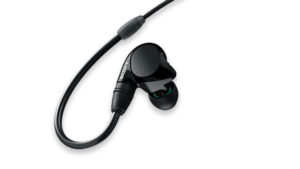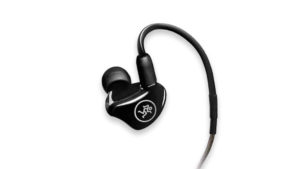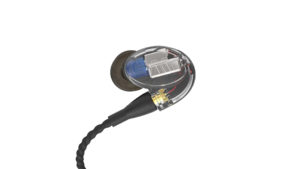Whenever you play live on stage, you need some method to hear what you’re playing. Many venues use traditional monitor wedges, but there’s another choice. I’m talking about in-ear monitors. These are dedicated personal monitoring devices that go straight into your ears.
Loads of major touring artists use in-ear monitors and lots of think about them as the best option for hearing yourself onstage. These days, in-ears are becoming more and more common even in smaller venues.
However what exactly are in-ears monitors? Are they just headphones? What are the specific benefits of using them and which models are best?
In this article, I’ll break down everything you should know to get started with in-ear monitoring.
What are in-ear monitors?
In-ear monitors are personal monitoring devices in a headphone format. They’re designed to go straight in a musician’s ears to provide the clearest, most direct monitor mix possible.
A set of in-ear screens is made up of a pair of headphones connected to a portable system that includes the amplifier circuitry, wireless receiver, and battery pack.
In-ear monitors are sometimes wireless devices that allow for better mobility and less bulky wiring, but hard-wired versions also exist.
Wireless in-ear systems make use of a transmitter device to send the signal to the artists that are performing on stage. They’re typically custom-molded for a personalized fit, but universal models work well for a lot of artists.
The snug fit offers extra sound isolation that decreases the external noise a musician could hear while wearing them.
In-ear monitors are headphones, but they’re built specifically to work in a live performance environment.
Why use in-ear monitors?
There are some challenges in modern concert production that in-ears help solve.
First off, in-ear monitoring is usually used on massive stages where the musicians move a considerable distance during their performance.
It’s not practical to make use of monitor wedges in these situations since there would have to be multiple setups for wherever players are located.
Not only that, in-ear monitoring gives a lot greater accuracy than traditional wedges. The increased sound quality and superior isolation can make it easier for musicians to deliver the best performance.
It’s essential to note that any loudspeaker monitoring setup has the potential to create runaway feedback. This happens when a performer’s microphone by chance points in the direction of the monitor speaker. The signal from the microphone makes a feedback loop.
These loud, harsh squeals are distracting for artists and audiences alike. In-ears eliminate them by removing the monitor wedge that makes the feedback loop.
Transmitters and receivers
As I mentioned above, any wireless in-ear system consists of some pieces:
- A transmitter unit that connects to the sound source and broadcasts the signal
- A receiver unit that clips to an artist’s clothing that connects to their headset
- The earphone speakers amplify the sound for the musicians to hear
One transmitter may be able to broadcast a signal to several receivers, allowing a whole band to receive a monitor mix from a single unit.
Generally, in-ear systems are sold in sets, so your best bet is to choose one with a suitable number of receivers for your needs. That said, it’s potential to add receivers individually with some units, so look for this possibility if you think you’ll eventually expand your system.
It’s also essential to notice that sending multiple monitor signals so each musician can hear a {custom} mix may not be potential with a single transmitter. There’s a lot of variation in terms of in-ears, so ensure you research them carefully!
The 7 best In-ears for musicians
While most transmitter/receiver pairs include a set of earphones, many musicians choose to buy their own for the best sound and fit.
In this list, I’ll be focusing mainly on the earphone element of an in-ear system since it has a significant effect on the sound quality.
1. Shure SE846
Here is the premium choice for in-ear headphones.
Despite looking similar to other pairs in this list, the Shure SE846 is sold at the price of $899!
While it may seem like an insane price to pay for earphones, the incredible sound quality makes them the best choice for giant tour productions.
If you need no-compromise sound, this one is for you.
2. Sennheiser IE 40 Pro
On the other end of the budget spectrum, you’ll discover the Sennheiser IE 40 Pro.
These reasonably priced IEM earphones deliver solid sound and comfort that won’t break the bank.
If you’re just looking to check out in-ear monitors without spending too much, the IE 40 Pros are an amazing choice.
3. Audio Technica ATH-E70
The Audio Technica ATH-E70 is a superb option for those who need high quality at a mid-tier price.
The design features a multi-driver configuration that delivers a clear sound with plenty of basses. That puts them within the realm of different professional budget earphones, but still accessible with quality that rivals the top contenders.
4. Sony IER-M7
Sony provides its line of excellent IEM earphones.
The IER-M7 is a solid choice that competes with lots of the best on this list.
While still firmly within the professional budget tier, you’ll get all the high-performance design philosophy of the pricier IER-M9 with few compromises.
5. Shure SE215 Pro
Shure is a large name when it comes to IEM systems.
Their respected SE series contains accessible models for all budgets, including the affordable SE215. At under $200, the SE215 is a single driver design, however, don’t let that stop you from considering them if cost is a concern.
6. Mackie MP-220
Live sound giant Mackie has many sets of respected in-ear monitors. The MP-220 is a budget-conscious pair with a step-up in sound quality thanks to its dual-driver design.
7. Westone Audio UM Pro 20
So much of finding the right IEMs is about fit and comfort.
If you’re having issues with IEM choices from traditional headphone manufacturers you might consider a pair from Westone Audio.
Like lots of the IEM earphones on this list, the UM series provides a broad range of offers at different price points.
The UM Pro 20 sits in a comfortable price range between professional and budget options.
In-ears to hear
It’s easy to see why many top touring artists use in-ears.
Their superior sound quality and noise isolation solve longstanding issues with traditional stage monitors.
If you’ve made it through this article you’ll have the background you need to get started with IEMs.








